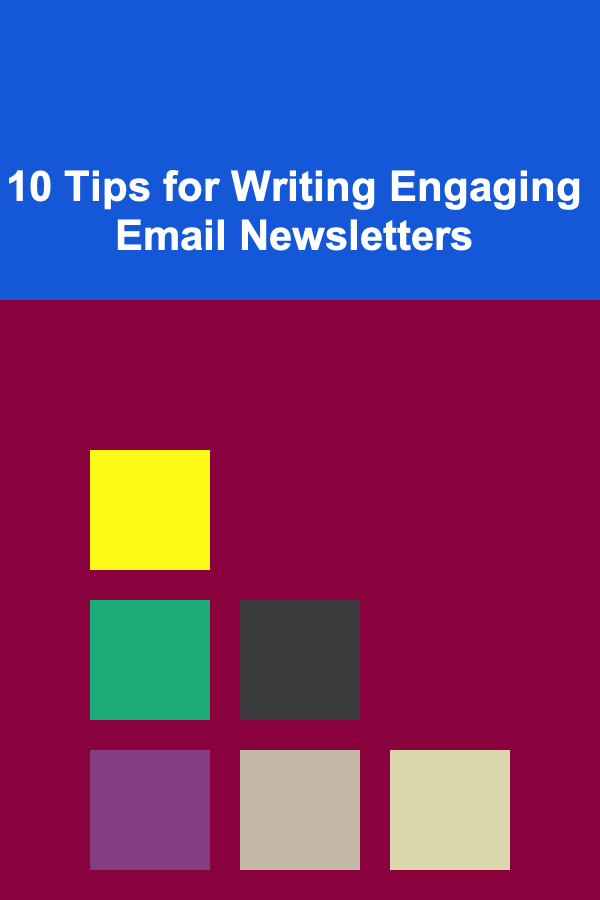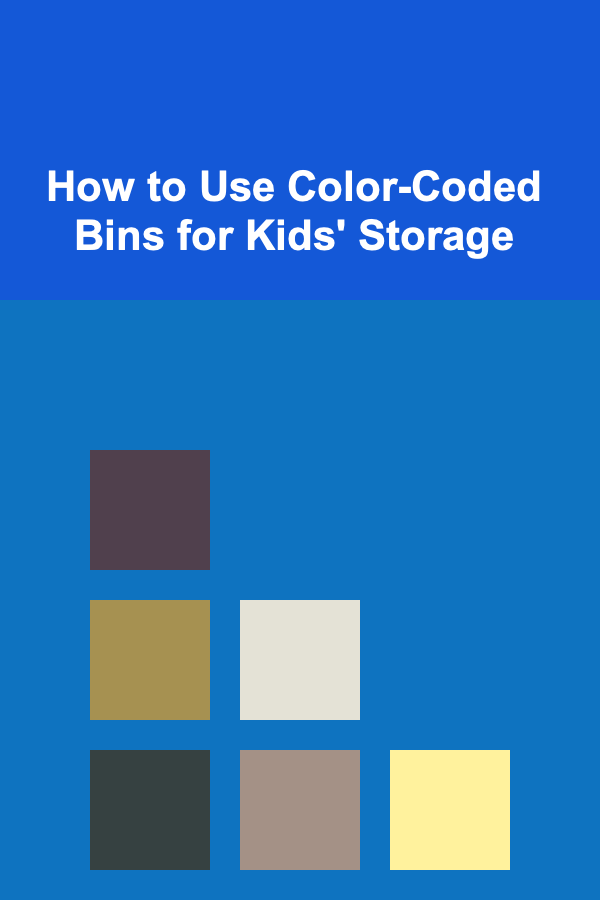
10 Tips for Writing Engaging Email Newsletters
ebook include PDF & Audio bundle (Micro Guide)
$12.99$5.99
Limited Time Offer! Order within the next:

Email newsletters remain one of the most effective ways to communicate with your audience, share valuable content, and build a strong relationship with your readers. However, in an age where inboxes are constantly overflowing, crafting an engaging and successful email newsletter has become a challenge. Whether you're a marketer, business owner, or content creator, the goal is to capture attention and inspire action, all while keeping readers interested and engaged.
In this article, we'll explore 10 essential tips for writing email newsletters that not only get opened but also keep your audience eagerly awaiting your next message. From personalization techniques to visual enhancements, we'll cover strategies that can significantly boost the effectiveness of your newsletters.
Understand Your Audience's Needs and Interests
Before you start writing your email newsletter, it's crucial to understand your audience's preferences and what content they find valuable. This helps ensure that your newsletters are relevant and engaging.
Audience Segmentation
- Demographics and behavior: Use data from your email list to segment your audience based on factors like age, location, purchase history, and engagement level. Tailor content to each segment to make it more personalized and impactful.
- Survey your audience: Occasionally ask your subscribers about their interests, challenges, or preferences. This feedback can help refine your content strategy.
Deliver Value
Focus on providing content that solves problems or adds value. Whether it's offering educational tips, industry insights, or exclusive discounts, ensure your readers feel that subscribing to your newsletter is beneficial.
Craft a Compelling Subject Line
The subject line is the first thing your readers see, and it plays a huge role in whether they open your email. A good subject line grabs attention, sparks curiosity, and clearly hints at the value inside.
Be Clear, Not Cryptic
While curiosity-driven subject lines can be effective, clarity is key. Make sure the reader knows what to expect inside the email. For instance, "5 Ways to Improve Your Social Media Strategy" is more actionable and clear than a vague "New Tips Inside."
Keep it Short and Sweet
Subject lines should be concise, as mobile devices cut off long text. Aim for 40-50 characters to ensure the message is fully visible.
Use Personalization
If possible, include the recipient's name or other personal elements in the subject line. Personalization can increase open rates significantly. For example: "John, Your Exclusive Offer Awaits Inside!"
Personalize the Content
Personalization goes beyond the subject line. Tailoring the content of your email to the individual preferences of your subscribers can drastically improve engagement and build a stronger relationship with your audience.
Dynamic Content Blocks
Use dynamic content to show different content to different segments of your email list. For instance, a retail brand might show different product recommendations based on past purchases.
Behavioral Trigger Emails
Send emails triggered by user behavior, such as a welcome email after they subscribe or an abandoned cart reminder. These types of emails are timely and relevant, making them more likely to be opened and acted upon.
Use First Names
Using a subscriber's first name in the email greeting adds a personal touch and makes the email feel more conversational and engaging.
Focus on the Value Proposition
People subscribe to your newsletter because they expect to gain something valuable in return, whether it's useful information, special offers, or entertainment. Therefore, your newsletter should consistently deliver on this promise.
Be Clear About What You Offer
State upfront what value the reader can expect from your newsletter. Whether it's educational tips, product updates, or discounts, make sure your audience knows why they should stay subscribed.
Exclusive Content
Consider offering subscribers exclusive content or deals that aren't available anywhere else. This makes your newsletter feel like a VIP experience and encourages readers to open it regularly.
Write a Strong, Engaging Intro
The opening of your email sets the tone for the rest of the content. It's important to write an engaging intro that draws readers in and encourages them to keep reading.
Tell a Story
Begin with a short, engaging anecdote or a story that relates to your content. Humans are wired to respond to stories, so this can be an excellent way to captivate your audience's attention.
Make It Scannable
Remember that many readers will skim through your email. Make your introduction easy to scan by using short paragraphs, bullet points, or subheadings. Highlight the key points to make it easy for readers to digest the main message.
Make Use of Visuals
Humans are naturally drawn to visuals. Including images, infographics, GIFs, and videos in your email newsletters can make your content more appealing and help convey your message more effectively.
Use High-Quality Images
Make sure the images you use are high-quality and relevant to your content. Blurry or irrelevant images can reduce the perceived professionalism of your newsletter.
Design for Mobile
Most emails are opened on mobile devices, so ensure your visuals are optimized for small screens. This includes using responsive design that adapts to different screen sizes and loading times.
Call to Action (CTA) Buttons
Use visually distinct CTA buttons that guide the reader to take action, whether it's clicking through to a blog post, making a purchase, or subscribing to a webinar. The button should stand out but still match your overall design.
Maintain a Consistent Brand Voice and Tone
Your email newsletter is an extension of your brand, so it's essential to maintain consistency in your voice and tone. Whether your brand is casual, professional, humorous, or inspirational, your emails should reflect that style.
Know Your Brand Personality
Define your brand's personality and make sure that tone is evident in your email copy. If your brand is fun and friendly, use informal language and humor. If it's more formal, maintain a professional tone.
Keep it Consistent Across Channels
Your email tone should match the voice you use on social media, your website, and other communication channels. Consistency helps reinforce your brand identity and builds trust with your audience.
Be Clear with Your Call to Action (CTA)
Every email newsletter should include a clear, compelling call to action (CTA). This is where you encourage your readers to take a specific action, such as reading a blog post, making a purchase, or signing up for an event.
Use Action-Oriented Language
Your CTA should use actionable language that tells the reader exactly what to do. Phrases like "Shop Now," "Learn More," or "Get Started" are direct and effective.
Limit CTAs to One or Two
Don't overwhelm your readers with too many choices. Stick to one or two CTAs per email to keep the message focused and clear.
Make Your CTA Stand Out
Use contrasting colors, bold fonts, or buttons to make your CTA visually prominent. It should be easy for readers to spot and act on.
Test and Optimize Your Newsletters
One of the keys to a successful email campaign is constantly testing and refining your approach. Testing allows you to understand what works and what doesn't, so you can continually improve your newsletter performance.
A/B Testing
Experiment with different elements of your email, such as subject lines, CTAs, images, or even the email layout. A/B testing helps you determine what resonates best with your audience.
Track Key Metrics
Monitor important email marketing metrics such as open rates, click-through rates (CTR), conversion rates, and unsubscribe rates. These metrics give you insight into how well your emails are performing and where you can improve.
Feedback and Adjustments
Solicit feedback from your subscribers periodically. This will help you understand what they like or dislike about your newsletters and provide insight into how you can better serve their needs.
Keep It Concise and Readable
In a world where people are constantly on the go, readers have limited time to engage with lengthy emails. Your newsletter should be concise, easy to read, and straight to the point.
Use Short Paragraphs
Break up your content into easily digestible chunks. Short paragraphs make it easier for readers to scan and absorb information quickly.
Bullet Points and Subheadings
Use bullet points and subheadings to organize information and guide readers through your content. This enhances readability and makes your newsletter easier to skim.
Edit Ruthlessly
Every word in your newsletter should add value. Avoid unnecessary jargon or fluff that could make your email feel bloated. Edit your content to be as concise and impactful as possible.
Writing engaging email newsletters requires a combination of strategy, creativity, and attention to detail. By understanding your audience, crafting compelling subject lines, personalizing content, and optimizing your design and CTAs, you can significantly improve the effectiveness of your email marketing campaigns. Testing and continuous improvement will help you refine your approach and ensure that your newsletters are consistently delivering value to your readers.
Reading More From Our Other Websites
- [Home Storage Solution 101] How to Create a Home Storage System for Digital Clutter
- [Home Soundproofing 101] How to Soundproof a Small Room for Maximum Noise Reduction
- [Tie-Dyeing Tip 101] How to Tie‑Dye Recycled Plastic Tote Bags for a Sustainable Fashion Statement
- [Organization Tip 101] How to Prepare Your Home for a Last-Minute Showing
- [Home Cleaning 101] How to Deep Clean Your Garage: A Step-by-Step Guide to Cleaning a Garage Like a Pro
- [Organization Tip 101] Best Organization Tools for Mental Health and Self-care
- [Home Maintenance 101] How to Extend the Lifespan of Your Major Appliances: Essential Maintenance Tasks
- [Organization Tip 101] How to Ensure Your Appliances Are Ready for the Move
- [Star Gazing Tip 101] From Constellations to Galaxies: Mastering Night Sky Navigation with Binoculars
- [Home Cleaning 101] How to Tackle Your Spring Cleaning Like a Pro

How to Designate Zones for Different Sewing Projects
Read More
How to Use Color-Coded Bins for Kids' Storage
Read More
What Are the Best Ideas for Organizing a Playroom?
Read More
How to Understand the Concept of Sacrifice in Mythology
Read More
How To Improve Your Professional Etiquette
Read More
How to Choose Between a Cash Back and Travel Card
Read MoreOther Products

How to Designate Zones for Different Sewing Projects
Read More
How to Use Color-Coded Bins for Kids' Storage
Read More
What Are the Best Ideas for Organizing a Playroom?
Read More
How to Understand the Concept of Sacrifice in Mythology
Read More
How To Improve Your Professional Etiquette
Read More